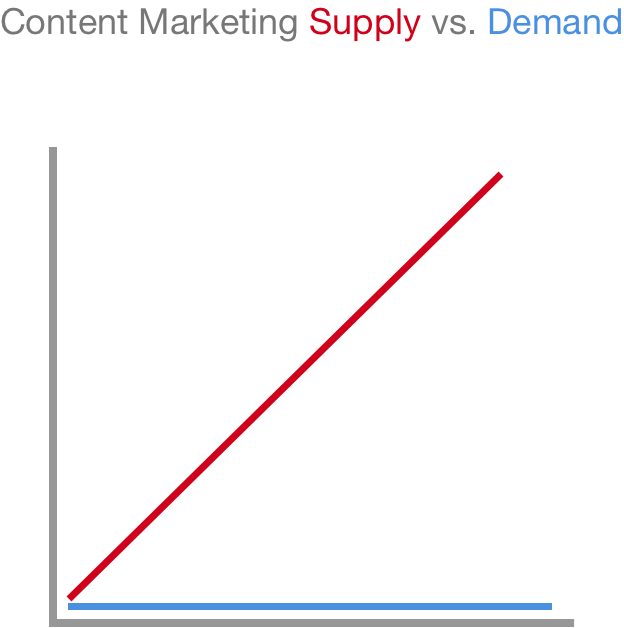Having a voice matters.
Just ask The Little Mermaid herself, Ariel. She couldn’t even get a rich, handsome prince to kiss her without her voice.
While marketers aren’t exactly angling for a smooch from Prince Eric (actually, I wouldn’t mind), having a voice has become vital in today’s content marketing landscape. This is because the demand for content is vastly outweighed by the supply of what’s already out there.
Brafton Creative Manager Lauren Fox used the graph below to illustrate this concept:

Via @jimmy_daly
“This challenge for content marketing, and blogging, is not new, and it isn’t going away anytime soon,” she explained. “What we need to focus on in the content we produce is the fight for the attention span of the user. There is so much noise out there and so much information at our fingertips.”
And brand voice is a crucial tool for capturing audience attention.
But creating and maintaining a voice on your company blog takes time and effort. As a marketer, you can’t expect to burst onto the scene, produce blog posts in any one voice and get immediate results. Just like with any aspect of content marketing, establishing a successful voice requires work.
Below, we tackle some of the most common questions about brand blogging voice, including how to create one, what makes a trademark blog voice and how you can keep it consistent throughout all touch points.
How can brands create their voice?
A voice needs to be determined before pen is put to paper – or in this case, fingertips are put to keyboard. The first step, as recommended by Brafton Director of Digital Marketing Strategy Jeff Baker, is to personify the brand. Think about your brand as if it were a person. What is that person’s job? How old are they? What is their favorite hobby? Which websites do they like to visit? Answering these kinds of questions lays out a foundation for developing that voice.
“Once you have a clear vision of the type of person your brand is, you will have a better idea of how that person would speak, and the things they would like to talk about,” Jeff explained. “The end result is visitors will feel like they’re interacting with a person rather than a corporate entity.”
Also, think about your audience and use that to inform your voice strategy. What kinds of content do they respond to most? Do they prefer more conversational or formal language? Knowing this information allows you to better craft a voice that resonates with who you’re speaking.

What makes for a ‘trademark’ brand voice?
It’s not all roses once you’ve established a voice, however. You’ve then got to work on keeping that voice consistent throughout your blog posts to turn it into a trademark voice.
You want your visitors to know when they are interacting with your brand, and having that trademark aspect makes your company recognizable.
“Trademark voices in blogs have a consistent point of view,” Lauren said. “They might be opinionated, funny, witty, etc. Most importantly, they are unique to the company because they embody the values of the business.”
Lauren added that another factor of a trademark voice is how it resonates with your audience. If your audience is listening, they are more likely to share your articles to their networks, comment on your content, ask questions and email in with questions.
Of course, the first voice you go with may not always turn out to be the right one.
“If you’re not getting the engagement you want, it might be a good time to adjust your voice, style and tone,” Lauren suggested. “Testing different styles to see what connects with your audience the most is just as important as user testing for your website, products or services.”
How can B2B brands strike a chord with their audiences through their voice?
B2B brands have long been thought of as boring, stuffy and full of confusing jargon, unlike their B2C counterparts that speak directly to consumers.
Well, that line of thinking is long gone. These days, B2B companies can use a more conversational and personal tone in their blogs that resonates with readers and establishes a connection. It’s all about speaking to people, not businesses.
“While you are communicating with people in a professional environment, you are still communicating with people,” Jeff explained. “Yes, they may be wearing a suit, but they are still human beings with commutes, hobbies, pets, etc. You need to look past the fact that you are marketing to a business, and start looking toward how to market to the people within that business.”
To avoid coming off as a sterile and yawn-worthy B2B company, focus on the people aspect, not the business one, and you’re sure to effectively connect with your audience.
Should I use the blog voice in other marketing collateral?
While the different types of marketing resources you create serve different purposes (i.e. blogs might be for increasing traffic, whereas an eBook may be for boosting conversions), Lauren stressed you need to maintain the same voice throughout.
She said you need to put yourself in your prospects’ shoes and think about what they see when they come to your site. When they first visit you, they probably don’t know much about your business, and when they read the messaging on your homepage or blog, this is the first time they “hear” your voice.
This is why you’ve got to keep that voice in all of the content you produce.
“The voice you hone in on in your blog content should absolutely carry through in every piece of collateral you create because it should consistently reflect your point of view as a company,” Lauren explained.
Your voice is a crucial component of your overall brand strategy. That’s why you’ve got to set the right tone in order to successfully connect with your audience.
By developing a voice, you may not sail off into the sunset with a prince like Ariel did, but you might invoke in them that warm and fuzzy feeling that comes with watching a Disney movie.





